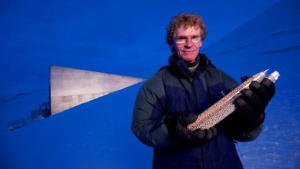Preparing for Change
In Seeds on Ice, Memphis native Cary Fowler explains the need for a global seed vault
In Svalbard, Norway, a remote archipelago above the Arctic Circle, there’s a tunnel drilled deep into a mountain, and within it are millions of seeds gathered from all over the world. This elaborate agricultural stash is the Svalbard Global Seed Vault, and it’s a planetary insurance policy against disease, pests, climate change, and any other calamity that might threaten the stability of our food supply. The seeds hold a wealth of genetic diversity to be called upon if ordinary genebanks fail. The vault itself is in large part the brainchild of Cary Fowler, a biodiversity expert originally from Memphis. In Seeds on Ice, Fowler explains why and how the vault came to be. The text accompanies a lavish collection of color photographs by Mari Tefre documenting the vault’s construction, as well as the extraordinary landscape that is its home.

The maintenance of crop diversity is critical to safeguarding the future of agriculture. Even without the global disruption of climate change, food crops are always under threat from constantly evolving diseases and pests, and there are genebanks all over the world devoted to preserving seeds and other sources of genetic material for breeding hardy plants. Unfortunately, these genebanks aren’t always well funded or maintained. Fowler writes of being sent on an inspection tour by the U.N Food and Agriculture Organization in the early 1990s and finding that many of the facilities were in such poor and deteriorating condition that they were “incapable” of performing their basic function of preservation. In 2003, in the wake of 9/11, concern about the security of even the best genebanks began to grow, and Fowler, then a professor at a Norwegian university, approached the government in Oslo about expanding an existing preservation facility in an abandoned Svalbard coal-mining shaft. This expansion would house duplicates of the world’s existing store of banked seeds—a back-up for the back-ups, so to speak.
Ultimately, the decision was made to create an entirely new facility at Svalbard, and Fowler gives a fascinating account of its design and subsequent construction in brutal Arctic conditions. The Norwegian government requires major construction projects to include a budget for art, and Fowler quotes artist Dyveke Sanne on the process of installing her light sculpture at the vault’s entrance during the polar night in January: “It’s cold in a way you can’t imagine,” Dyveke recalled. “I wore motorcycle goggles because the cold wind can pop your eyes. When I was working outside alone,” she said, “I would take overexposed photographs of my surroundings with my digital camera in order to check for ice bears.”
 Those “ice bears”—the local term for polar bears—are an ever-present concern, so much so that residents routinely carry rifles for protection, and Fowler notes that he always checks for them before exiting the vault. Tefre’s photograph of a wet and somber-seeming bear standing alone on the ice conveys a sense of the unforgiving rule of nature in Svalbard, as do her starkly beautiful pictures of the landscape. There are some lovely images from more temperate parts of the world, as well—a nod to the sources of the vault’s treasures. One particularly stunning shot shows an Ethiopian woman making injera as the sun streams through the thatch of her home, blessing her with light. The sacred quality in this photo is strangely echoed in a radically different image of Fowler near the vault’s entrance, holding aloft some seed samples and looking like a priest performing some holy rite.
Those “ice bears”—the local term for polar bears—are an ever-present concern, so much so that residents routinely carry rifles for protection, and Fowler notes that he always checks for them before exiting the vault. Tefre’s photograph of a wet and somber-seeming bear standing alone on the ice conveys a sense of the unforgiving rule of nature in Svalbard, as do her starkly beautiful pictures of the landscape. There are some lovely images from more temperate parts of the world, as well—a nod to the sources of the vault’s treasures. One particularly stunning shot shows an Ethiopian woman making injera as the sun streams through the thatch of her home, blessing her with light. The sacred quality in this photo is strangely echoed in a radically different image of Fowler near the vault’s entrance, holding aloft some seed samples and looking like a priest performing some holy rite.
The Svalbard vault is an extraordinary achievement, but it has not been without controversy. Its momentous purpose and its remote location give the project a certain dystopian aura, and it has inspired a number of conspiracy theories, including the claim that it was built as a ruse through which biotech giant Monsanto could lay claim to the world’s store of seeds. (In fact, Monsanto has nothing to do with the project.) Fowler expresses some exasperation with the rumors and objects to the characterization of the vault as a “doomsday” project. The vault was “not built in a spirit of pessimism,” he insists, but rather by people who simply wanted to take action “so that humanity and its crops might be better prepared for change.”

Maria Browning is a fifth-generation Tennessean who grew up in Erin and Nashville. A graduate of Mount Holyoke College, she has attended the Clothesline School of Writing in Chicago, the Moss Workshop with Richard Bausch at the University of Memphis, and the Sewanee Writers’ Conference. She lives in White Bluff.


